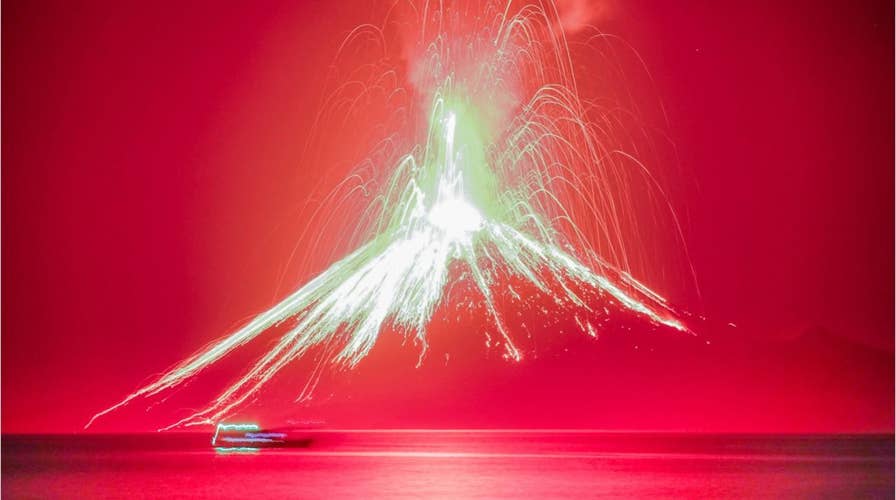California’s uncanny “earthquake pause” is over. It should have already had several “big ones” by now. All that pressure has to go somewhere. Now geologists are nervously eyeing eight nearby volcanoes. And why has Yellowstone supervolcano been acting so weird?
The U.S. Geological Survey (USGS) has warned Southern California to expect more big earthquakes to come. Some, they say, may even be more powerful than those experienced in the past few days.
“(These quakes do) not make (the Big One) less likely,” local seismologist Lucy Jones told The Los Angeles Times. “There is about a one in 20 chance that this location will be having an even bigger earthquake in the next few days, that we have not yet seen the biggest earthquake of the sequence.”
In part, that’s because California is way overdue for “the Big One.”
The past century has been abnormally quiet in terms of large, ground-rupturing earthquakes.
The last “Big One” was in 1906 when a force 7.9 earthquake realigned the real estate of San Francisco.
And U.S. geologists are beginning to suspect this is not just a lucky roll of the dice.
Something deep under California appears to be changing. And its implications are yet to be understood.
OMINOUS SILENCE
The past week’s earthquakes are the most significant experienced by Southern California since 1999. Then, a 7.1 magnitude event tore through the remote Mojave Desert.
It was an isolated event. And it wasn’t a surface quake, either.
“We’re unusually quiet,” co-author of a recent study, The Current Unlikely Earthquake Hiatus, Glenn Biasi, told Live Science in April. “The biggest faults and the faults carrying most of the slip have not ponied up.”
Something has broken the geological pattern.
The USGS has carefully scoured California’s terrain for evidence of past earthquakes. They know how many lives could potentially be at stake. And forewarned is forearmed.
They’ve assembled seismic records dating back some 1,000 years at 12 key sites along the Golden State’s major fault lines — the extensive San Andreas Fault, the Hayward Fault and the San Jacinto Fault.
That data reveals the odds of all three faults being quiet for 100 years is next to none.
Instead, the USGS study says California should have expected about six “Big Ones”.
“We do not think it’s happened in the previous thousand years,” Mr. Biasi said.
The quake “hiatus” remains a mystery. Speculation that the faults had merely vented much of their pent-up tension in an unusually active 1800s remains that — speculation.
Another possibility remains: That there is something even deeper, something so big that it is causing the activity of the state’s five major fault lines to “synchronize.”
EXPLOSIVE IMPLICATIONS
“The potential for damaging earthquakes, landslides, floods, tsunamis and wildfires is widely recognized in California,” another recent USGS report reads. “The same cannot be said for volcanic eruptions, even though they occur in the state about as frequently as the largest earthquakes on the San Andreas Fault.”
Of the state’s eight volcanoes, seven have been found to sit above “active” magma chambers.
Disturbingly, it finds some 200,000 people are classified as “at-risk” if an eruption was to occur. And it argues there is a 16 percent chance of such an event within the next 30 years.
Like the fault-line studies, geologists have pulled clues from California’s landscape to determine volcanic activity over the past 5,000 years.
It’s found five volcanoes – Mount Shasta, Medicine Lake, Lassen, Long Valley and Salton Buttes – have erupted during the past 3000 years. Clear Lake Volcanic Field near San Francisco – while rated as potentially of very high risk – hasn’t blown for longer.
The trick is in predicting when the next eruption is likely to occur.
It’s an inexact science. But there are clues.
GPS sensors and satellite radars are used to measure deformations in the volcanoes’ surfaces. Seismometers detect subterranean movements. Gas emissions are regularly tested for changes in content.
So far, all eight remain quiet.
CORE ISSUE
The Earth’s molten heart is always on the move. Movements deep beneath the crust are believed to be behind the North Pole’s shifting magnetic field. There’s a magnetic “anomaly” in the South Atlantic that’s even giving some satellites headaches.
The geysers at Yellowstone National Park – which sits above the world’s biggest “supervolcano” – have been acting erratically.
Is there any link?
Seismologists say there is simply no evidence to support this. And a surface quake in California won’t have any impact on Yellowstone, some 1,000 km away.
But speculation remains rife: Social media is awash with supervolcano talk.
So what do the experts think? The USGS unit specifically tasked with monitoring the famous geysers and the monster that lurks beneath has been baffled by shifting patterns in normally regular geyser eruptions.
When it comes to the activity of the enormous magma chamber far beneath, though, little has changed. Instead, changes in a “crystal mush” within the Yellowstone chamber itself are believed to be distorting the hydrothermal channels feeding the park’s biggest attractions.
This story originally appeared in news.com.au.





















